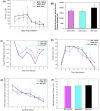Genomic and virulence analysis of in vitro cultured Cryptosporidium parvum
- PMID: 38416794
- PMCID: PMC10927135
- DOI: 10.1371/journal.ppat.1011992
Genomic and virulence analysis of in vitro cultured Cryptosporidium parvum
Abstract
Recent advances in the in vitro cultivation of Cryptosporidium parvum using hollow fiber bioreactor technology (HFB) have permitted continuous growth of parasites that complete all life cycle stages. The method provides access to all stages of the parasite and provides a method for non-animal production of oocysts for use in clinical trials. Here we examined the effect of long-term (>20 months) in vitro culture on virulence-factors, genome conservation, and in vivo pathogenicity of the host by in vitro cultured parasites. We find low-level sequence variation that is consistent with that observed in calf-passaged parasites. Further using a calf model infection, oocysts obtained from the HFB caused diarrhea of the same volume, duration and oocyst shedding intensity as in vivo passaged parasites.
Copyright: © 2024 Yarlett et al. This is an open access article distributed under the terms of the Creative Commons Attribution License, which permits unrestricted use, distribution, and reproduction in any medium, provided the original author and source are credited.
Conflict of interest statement
The authors have declared that no competing interests exist.
Figures




Similar articles
-
Genetic Ablation of a Female-Specific Apetala 2 Transcription Factor Blocks Oocyst Shedding in Cryptosporidium parvum.mBio. 2023 Apr 25;14(2):e0326122. doi: 10.1128/mbio.03261-22. Epub 2023 Feb 14. mBio. 2023. PMID: 36786597 Free PMC article.
-
Virulence of geographically different Cryptosporidium parvum isolates in experimental animal model.Ann Parasitol. 2016 Oct 1;62(3):221-32. doi: 10.17420/ap6203.56. Ann Parasitol. 2016. PMID: 27770762
-
Cryptosporidium parvum: determination of ID₅₀ and the dose-response relationship in experimentally challenged dairy calves.Vet Parasitol. 2013 Oct 18;197(1-2):104-12. doi: 10.1016/j.vetpar.2013.04.022. Epub 2013 Apr 20. Vet Parasitol. 2013. PMID: 23680540 Free PMC article.
-
[The significance of cryptosporidiosis for the health of calves in Switzerland].Schweiz Arch Tierheilkd. 2018 Jun;160(6):363-374. doi: 10.17236/sat00163. Schweiz Arch Tierheilkd. 2018. PMID: 29905160 Review. German.
-
Challenges for Cryptosporidium Population Studies.Genes (Basel). 2021 Jun 10;12(6):894. doi: 10.3390/genes12060894. Genes (Basel). 2021. PMID: 34200631 Free PMC article. Review.
Cited by
-
A Pumpless and Tubeless Microfluidic Device Enables Extended In Vitro Development of Cryptosporidium parvum.Open Forum Infect Dis. 2024 Oct 16;11(11):ofae625. doi: 10.1093/ofid/ofae625. eCollection 2024 Nov. Open Forum Infect Dis. 2024. PMID: 39512424 Free PMC article.
-
Rapid review: Recent advances in in vitro models for the study of Cryptosporidium parvum.Curr Res Parasitol Vector Borne Dis. 2025 May 15;7:100269. doi: 10.1016/j.crpvbd.2025.100269. eCollection 2025. Curr Res Parasitol Vector Borne Dis. 2025. PMID: 40495915 Free PMC article. Review.
-
Molecular Epidemiological Survey of Cryptosporidium in Ochotona curzoniae and Bos grunniens of Zoige County, Sichuan Province.Animals (Basel). 2025 Jul 19;15(14):2140. doi: 10.3390/ani15142140. Animals (Basel). 2025. PMID: 40723603 Free PMC article.
References
-
- Kotloff KL, Nataro JP, Blackwelder WC, Nasrin D, Farag TH, Panchalingam S, et al.. Burden and aetiology of diarrhoeal disease in infants and young children in developing countries (the Global Enteric Multicenter Study, GEMS): a prospective, case-control study. Lancet. 2013;382(9888):209–222. doi: 10.1016/S0140-6736(13)60844-2 - DOI - PubMed
-
- Sow SO, Muhsen K, Nasrin D, Blackwelder WC, Wu Y, Farag TH, et al.. The Burden of Cryptosporidium Diarrheal Disease among Children < 24 Months of Age in Moderate/High Mortality Regions of Sub-Saharan Africa and South Asia, utilizing Data from the Global Enteric Multicenter Study (GEMS). PLoS Negl Trop Dis. 2016;10(5):e0004729. - PMC - PubMed
-
- Guerrant DI, Moore SR, Lima AA, Patrick PD, Schorling JB, Guerrant RL. Association of early childhood diarrhea and cryptosporidiosis with impaired physical fitness and cognitive function four-seven years later in a poor urban community in northeast Brazil. Am J Trop Med Hyg. 1999;61(5):707–713. doi: 10.4269/ajtmh.1999.61.707 - DOI - PubMed

